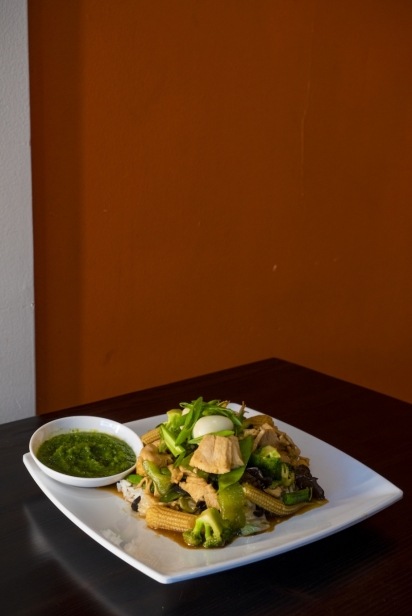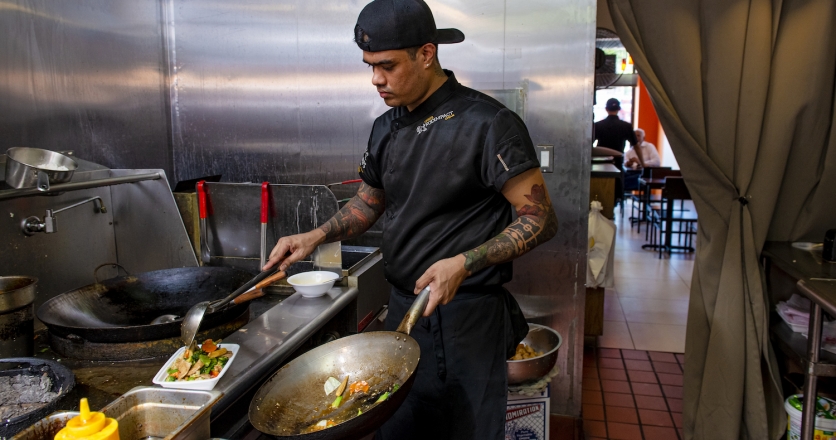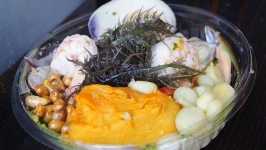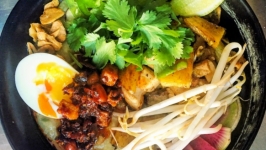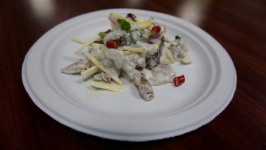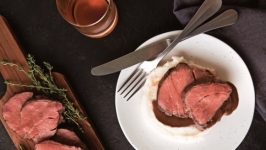Asian Bowl
There’s a new salad in town, a Burmese fermented tea leaf salad called laphet, latphat or laphat (LAH-fat) thoke. Thokes are dense, ingredient-packed, room-temperature salads—and there’s a wide variety available at Asian Bowl, whose new owners have injected some traditional Burmese flavor into Forest Hills since February 2019. It’s one of two brick-and-mortar Burmese restaurants in New York City.
The laphet thoke’s fermented green tea leaves are the star of the show, though there are as many as 20 other ingredients vying for attention and making this salad crunchy, refreshing, citrus-y and slightly funky. The tea leaves: earthy, herbal, a little bitter and pungent. The long list of mix-ins includes crispy dried green butter beans; puffed yellow split peas; crunchy fried garlic, cashews and peanuts; sunflower and sesame seeds; briny dried shrimp; raw chili peppers for a kick; fresh tomato slices and raw cabbage—all tossed with tea leaf liquid, vegetable oil and lime.
“In Burma, we mostly eat laphet thoke in the daytime because it is made from tea leaves. They have caffeine. So late at night, some people don’t eat it,” says John Htin, the co-owner of this family business.
Htin sources tea leaves straight from Burma where the best crop is allotted for both eating and drinking purposes. The freshly harvested tea leaves are briefly steamed, then weighted in containers to ferment.
“Everybody, every home in Burma eats this,” he says. You can find laphet easily there, even in the grocery stores.
The tea leaf salad is one of 13 thokes on the restaurant’s Burmese-first Asian-fusion menu. Bases range from thick noodles to rice; the thoke section offers nan gyi thoke with thick rice noodles, hard-boiled egg and yellow bean powder; hta-min thoke with rice and tomato purée; or gin thoke with no carb base but a load of ginger.
The Burmese recipes come from Htin’s wife, Aye Thida, and her family, who ran restaurants for over 20 years in Yangong, Burma. The rest of the menu features Thai, Americanized Chinese and Japanese dishes reflective of Htin’s desire to satisfy his diverse clientele and his 10+ years working up and down the restaurant hierarchy at sushi restaurants including West Side Sushi, Haru, Benihana and Sushi with Gusto after dropping out of his electrical engineering classes at City College.
When you’re an immigrant, he says, “It’s easy to find restaurant jobs … and I will take whatever I can for work.”
Inspired by the “opportunity that America provides” and an adventurous spirit—“If there’s a mountain, I want to see what’s on the other side,” Htin says—he won the green card lottery and arrived in New York in 2000. Thida joined him here two years later.
They started considering opening a restaurant three years ago. “We just want to start our own business. And we want to serve Burmese food in our neighborhood. We live in Queens for a long time,” says the Elmhurst resident.
In February, they took over the eight-table former Chinese takeout spot. Asian Bowl is a five-person business—sometimes six, on busy weekends when a second delivery guy is needed—with a kitchen run by his wife, mother-in-law and brother-in-law. You’ll see them behind the kitchen curtains, delivering steaming dishes for Htin to serve.
Htin laughs with a Burmese couple taking food photos, and educates non-Burmese customers about his culture’s cuisine, still unfamiliar to most New Yorkers.
Htin says people come from Brooklyn, New Jersey, Long Island—news of their restaurant has spread quickly through the Burmese community via word-of-mouth and Burmese media. He smiled broadly as the couple left with four bulging bags of food to take back to Brooklyn.
Asian Bowl
Haru | @harusushinyc
Benihana | @benihana
Sushi with Gusto | @sushiwithgusto




